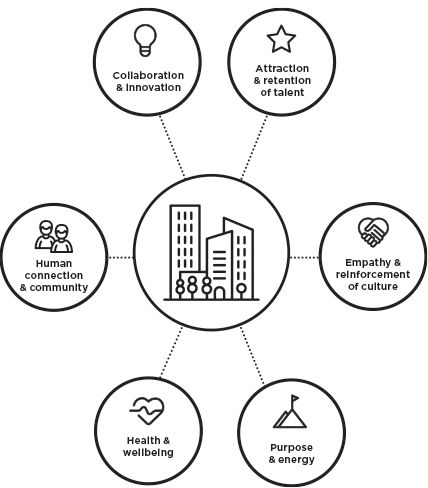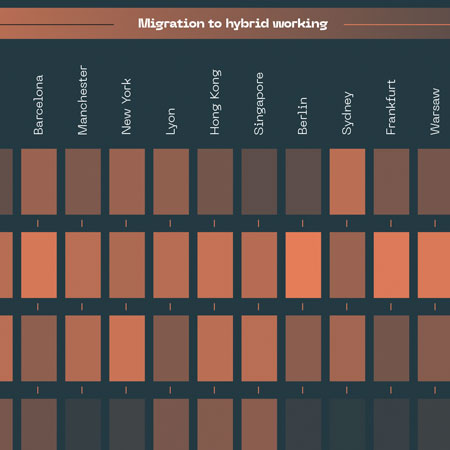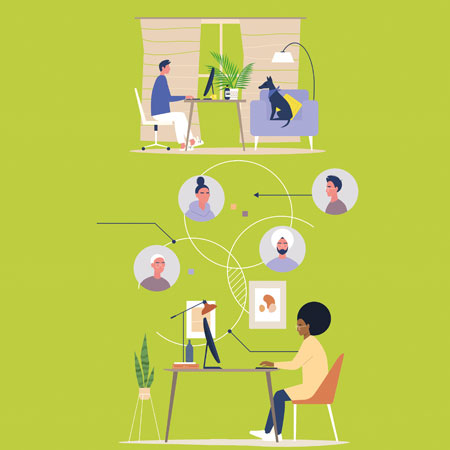Connection, culture & collaboration will guide the evolution of the workplace
The need to bring people together and provide opportunities to work in multiple locations will shape the future of the workplace. Companies will need clear goals to make a successful transition that provides synergy between employer, employee and the goals of the organisation.
We’ve all learnt from the work-from-home experience but, ultimately, most companies agree that culture can be irretrievably eroded if people do not have the opportunity to come together. For employees, the return to the office is also about the need to get back to something that is recognisable; to regain a sense of who they are and to belong to a community again – whether that’s corporate or personal.
For companies, this transition is when they need to be absolutely clear about their goals, their aspirations and policies, and the need to shape the workplace around them. This is a critical time for companies to manage the adjustment and support behavioural change for employees.
A responsive strategic framework can help a business demonstrate the value that a dynamic workplace contributes to any organisation; it can meet the main challenges of aligning the physical and digital workplace with its people.
Resetting the balance
Companies need to think about three aspects. First is flexibility, and how to support that in the office. Second is managing the initial return to the office and making sure that people perceive the workplace to be safe and prepared, and that their needs are being met. The final factor is risk: the risk of a two-tier culture with flexible working for those in and out of the office; the risk of cybercrime with working at home; and the risk of not managing the change associated with this transition.
Flexibility should be embedded in the office set-up. Workers need a choice of work settings – they are coming into the office to be with people so that needs to be fostered in. In addition, they will need quiet spaces and focus spaces. For convenience, employees will now want to combine being in the office for meetings with areas that mirror the focus of the work-from-home environment.
Virtual calls will continue in the office environment, so companies will need to manage their meeting room strategies or they will find themselves in a position where everybody is at their desk with headphones on or talking over each other.
The mix in the office between virtual and in-person has to eliminate presenteeism. Pre-pandemic, those people who were not physically at work suffered as they were usually a minority. This will change.
The configuration of rooms, the size of screens and the etiquette around meetings is also set to develop with a need for improved acoustics to minimise disruption and curated backdrops to engage with virtual images. There are many furniture solutions on the market that will allow minor reconfiguration in the short term.
Agile workspaces
The likely midweek rush from Tuesday to Thursday will need to be managed by implementing team policies about who is in to cover the week, but also to create the ‘buzz’ we crave as social beings. Flexible solutions can support this busier period. Bigger meeting rooms can be created midweek for large team meetings, while screens and dividers can devise smaller settings for quieter days. Companies must be aware that wider corridors and circular motion flows around amenity spaces are also important to office design.
While settings should balance needs, employees should use space considerately, thinking about what they are going to be doing and using it appropriately. This requires planning and behavioural change.
Managing expectations
Management of how the office is to be used is vital. People respond to rules, and companies will have to consider what is the right model for them if they are adopting different working environments. If people understand what is expected, navigating the new workplace will be less stressful. They can plan their tasks and focus on what matters to the organisation and themselves.
Companies also have to remember that they are not going to get it right first time. This is going to be an evolution and 2021 is the year of transition. The human aspects of the pandemic have been huge. Companies must be mindful that each person will have had different experiences. Businesses should see how people are responding and make intelligent decisions about adapting the workplace, ensuring that those both in and not in the office, do not feel exiled.
The office is certainly not dead, but it will definitely change and there will not be one solution for all. The need to bring people together has been highlighted by the pandemic, as have the opportunities that exist to work in multiple locations, delivering solutions that can work individually and collectively. Unsurprisingly, there will be greater hubs for collaboration and innovation in a flexible environment, providing synergy between the employer, the employee and the commercial goals of the organisation.
The physical workplace creates a vital ecosystem for people to thrive




